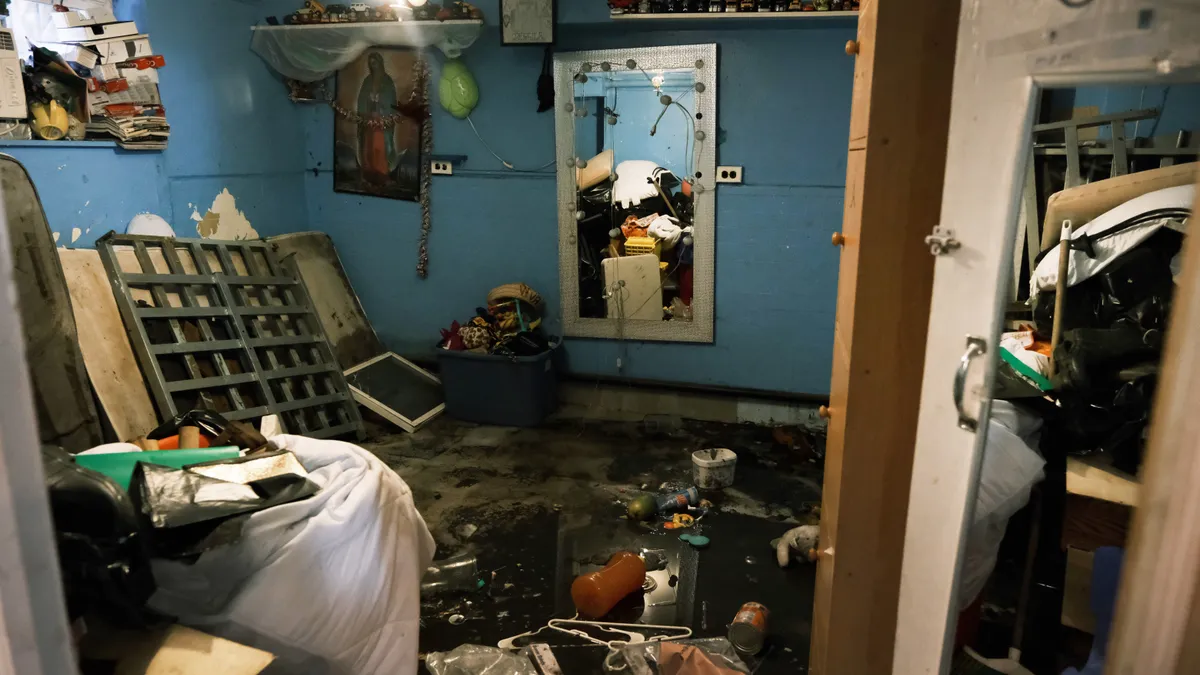Dive Brief:
- One year after heavy rain from Hurricane Ida hit New York City and subsequently killed 11 people living in “mostly-unregulated” basement apartments, the Citizens Housing and Planning Council shared an action plan this week for basement flood safety and stormwater equity in the city.
- The research and education nonprofit calls for a practical pathway to basement apartment legalization. It also urges the city to leverage push-alert notifications to communicate risk to residents; require that property owners and renters have flash flood safety plans; and implement a stormwater fee to reflect a property’s impact on city wastewater infrastructure.
- New York City Comptroller Brad Lander released his own report Tuesday proposing the state adopt legislation “with clear rights and responsibilities for basement owners and dwellers, as part of a more comprehensive approach to legalizing and expanding accessory dwelling units.” Such protections could provide an immediate impact while city and state officials draw out a less burdensome pathway to legalization, the comptroller report explained.
Dive Insight:
Amid climate change, cities are facing catastrophic and costly urban flood events caused by weather patterns like hurricanes, as was the case in New York City last year, or record rainfall following drought, like in Dallas last week. These events threaten transportation, housing and other basic infrastructure. More than 100 families are reportedly still living in hotels after being displaced by the remnants of Hurricane Ida.
Basement dwellers in particular face unique drowning risks in these scenarios, as occurred in New York City during Ida. According to the comptroller report, tens of thousands of people in New York, many of them working-class immigrants and people of color, reside in basement and cellar apartments, “most of which exist within an informal rental market due to regulatory and financial barriers.”
New York City’s housing affordability crisis is one of the ongoing drivers of basement dwelling. Basement dwellers further face notable risks from fires and eviction because they lack tenant protections, the comptroller also noted.
Legalization remains elusive, with legislation supporting that effort having stalled last session in Albany, the comptroller’s report stated. “As the City and State consider next steps in responding to the overlapping nature of our affordable housing and climate crises, the anniversary of Hurricane Ida must prompt bolder action – to provide basic, immediate protections to the thousands of New Yorkers currently living in basement units, as well as a pathway to legalization through State legislation.”
The comptroller’s release said a Basement Resident Protection Law would follow in the path of 1982’s Loft Law, which formalized protections for loft tenants in converted buildings who previously lacked physical safety or legal protections.
Among new protections, the release outlined that such a law ought to mandate and help fund the installation of carbon monoxide detectors, smoke alarms and backflow preventers; implement better data systems for early flood warning systems; provide a registration framework aligned with ongoing safety inspections and longer-term legalization efforts; and require that affordable housing be available to residents of units deemed unfit for living.
CHPC’s report calls for both protections and a path to legalization. “Rather than make the regulatory framework that is partly responsible for discouraging the legalization of basement units more restrictive, the city should streamline a path to compliance, incentivize installation of essential safety features, and help residential properties with projected flood risk to meet a higher standard of storm safety,” the report states.
One of CHPC’s main focus points is stormwater, saying that stormwater flooding presents a more widespread impact to residential properties than coastal flooding. Stormwater runoff is generated by nearly all properties yet its costly impacts are borne by a small proportion of residents, the organization asserts. That focal point comes as local news outlet The City recently reported that New York City denied over 4,700 financial claims filed against the city following damage from Ida, largely centered on negligence in sewer maintenance.
New York rolled out some mitigation efforts this summer, including distributing inflatable dams to homeowners and attempting to reduce chronic neighborhood flooding by implementing green infrastructure in a few roadway medians.
Other cities are trying a variety of strategies to become more resilient to flooding. The Federal Emergency Management Agency has increased funding for local governments to undertake proactive hazard mitigation projects. The “sponge cities” concept has been popularized for cities to consider how permeable they are to water, and how nature-based solutions can help. And Philadelphia is considering how it could potentially conduct a “land swap” to move vulnerable residents out of low-lying, flood-prone areas.











